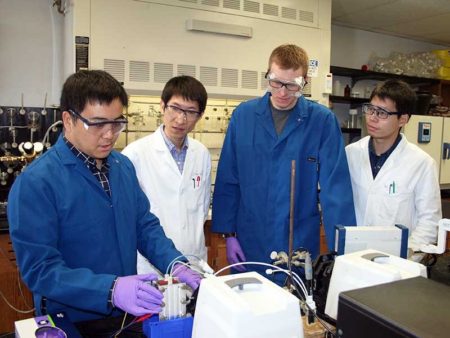Apr
4
Two Electron Structure For Redox Flow Batteries
April 4, 2018 | Leave a Comment
Utah State University chemists have demonstrated a two electron storage anolyte structure for aqueous redox flow batteries. The chemists have designed and synthesized a pi-conjugation-extended viologen molecule.
The chemists’ efforts is to develop and advance alternative battery technology solutions and their recent findings are highlighted in new research paper. Tianbiao Liu, assistant professor in USU’s Department of Chemistry and Biochemistry, and his team reported the new molecular design for aqueous organic redox flow batteries, known as AORFBs, in the journal Angewandte Cheimie. In addition to Liu, the paper’s authors are USU postdoctoral researcher Jian Luo and doctoral students Bo Hu and Camden DeBruler.

Utah State University chemists, from left, Tianbiao Liu, Bo Hu, Camden DeBruler and Jian Luo describe the design and synthesis of a pi-conjugation-extended viologen molecule as a novel, two-electron storage anolyte for neutral total organic aqueous redox flow batteries. Image Credit: Mary-Ann Muffoletto/USU. Click image for the largest view.
Liu offered this background, “Organic redox flow batteries show promise for large-scale storage of renewable energy, as redox-active organic molecules are synthetically tunable, sustainable and inexpensive. We think they’re a great alternative to existing technologies to meet growing demand for battery storage of environmentally friendly, renewable energy resources such as solar and wind power.”
Such renewable energy sources present challenges to use, he explained, because of their intermittent availability, unstable, heavy cycling and grid energy demands. These sources require frequent changing and discharging, as well as irregular, full recharging of a robust battery.
In their paper, team members describe use of synthetic chemistry to design a molecule, featuring a pi-electron conjugation unit, as a novel, two-electron storage anolyte for neutral total organic AORFBs.
Liu said, “The two-electron structure is a unique feature of this design. It enables total use of organic materials based on abundantly available elements, such as nitrogen and hydrogen.”
The chemists’ demonstrated battery delivered a high voltage of 1.44 volts in an aqueous electrolyte, along with impressive energy efficiency and capacity retention.
“The design is very robust and very stable,” Liu said.
Observing a long-time tradition of Angewandte Chemie, Liu dedicated the paper to his master’s mentor, Professor Mei Wang of China’s Dalian University of Technology, on the occasion of her 62nd birthday. “Dr. Wang is among the leaders in the field of renewable energy chemistry and was an inspiration to me,” he said.
The press release is rather thin and the abstract isn’t very helpful on the capacity increase from a doubling of available electrons. In the same vein, the voltage doesn’t seem high although it might be enough. But the wind and solar industries might need this boost, as the availability and capacity issues are far from competitive and there is much more competition coming. For wind and solar much more than steady winds and sunshine are going to be needed. Costs are going to have to come down and the subsidies are sure to end. Low cost batteries alone won’t likely be enough.
But there is great potential suggested in this work. It is worth more effort and further development. But, we’re going to need that capacity increase announcement.

